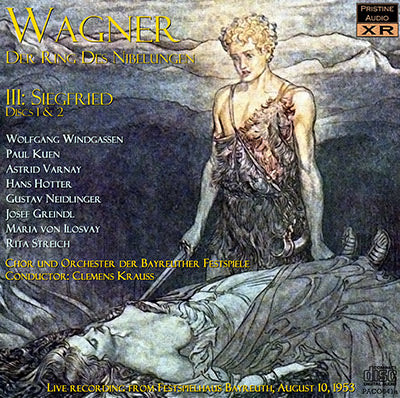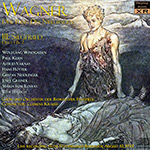
This album is included in the following sets:
This set contains the following albums:
- Producer's Note
- Full Cast Listing
- Cover Art
The legendary Windgassen's first appearance as Siegfried
Krauss keeps up his incredibly high standard in this third Ring installment
My notes for the two previous operas in this Ring cycle suggested clear sonic improvements between the first and second opera. Here is Siegfried from day three of Krauss's August 1953 Ring cycle, and technically it's often better still. This XR remastering has succeeded at both ends of the audio spectrum - bringing out a much fuller, deeper and richer bass than previously heard whilst also extending and brightening the top end.
The approach has revealed a very slight peak distortion in the original which generally only affects a narrow frequency range during fortissimo vocals, but it's a minor quibble. There was also some minor audible quality variation between recorded sections - manifested as a slightly lower treble response for some periods during the recording - which I've generally managed to even out, but overall the sound quality is excellent and notable for a lack of drop-outs and the other sonic shortcomings one might normally expect from any recording of this vintage, be it studio or live.
In short, it's technically pretty remarkable, with low noise levels, clear constant sound and, if you choose the FLAC or MP3 downloads, uninterrupted listening through each act, something impossible with standard CDs. I followed the example of Solti's classic 1962 recording in selecting track marker points throughout (a surprisingly laborious process!) but used different (and perhaps more appropriate to the present recording) point in the music with which to end and begin discs 1-3. The Solti also served as a sonic reference for the overall re-equalisation of the recording, which had previously been very thin in the bass and lower mid-range.
Andrew Rose
-
WAGNER - Siegfried WWV 86C
Siegfried - Wolfgang Windgassen
Mime - Paul Kuen
Brünnhilde - Astrid Varnay
Wanderer - Hans Hotter
Alberich - Gustav Neidlinger
Fafner - Josef Greindl
Erda - Maria von Ilosvay
Waldvogel - Rita Streich
Choir and Orchestra of the Bayreuth Festival
conductor Clemens Krauss
Live concert recording, Bayreuth Festival, 10th August 1953
Fanfare Review
Pristine Audio’s restoration of Siegfried and Götterdammerung brings new clarity and vividness to the sound of these performances
I find the 1953 Bayreuth Ring conducted by Clemens Krauss and the 1955 Keilberth version to be the most consistently satisfying of all complete live-recorded Rings. The Krauss has been issued quite a few times in decent mono sound but Pristine Audio’s restoration of Siegfried and Götterdammerung (along with the first two operas) brings new clarity and vividness to the sound of these performances. The quality of the orchestral sound is where one hears the most notable improvement; it’s less congested, and many previously obscured details emerge.
Comparing the Pristine Siegfried to a copy on Gala, one hears the difference right away. On Gala, the eerie prelude that opens the first act is interrupted by a loud cough (at :02) and a squeak (at :04) followed by a murky, indistinct sound to the low-lying instrumental lines. In the Pristine remastering, there’s less surface hiss, the cough and squeak are gone, and one can appreciate the nuanced playing of the opening contrabass tuba solo, a sinister sound that evokes Fafner, the dragon.
Siegfried’s first two acts come across particularly well thanks to Krauss’s pacing and exceptionally fine playing by the orchestra. He achieves the sense of detailed storytelling in his lively, responsive pacing of Wagner’s large structures. The orchestra is always well synchronized with the singers. Climaxes are suitably exciting.
As Siegfried, Windgassen has good musical instincts and enough rich tone and stamina to succeed in this tiring role. At times, there is something a bit thin and vulnerable about his singing that fits well with the character of the young Siegfried, a fool like the young Parsifal, another role in which the young Windgassen excelled. The most rewarding performances in this Siegfried come from the great singing actors Paul Kuen and Gustav Neidlinger, fully immersed in their roles, along with Hans Hotter, a truly great Wotan, captured here in vocally fine condition.
In the sublime third act, the encounters of Wotan and Erda (the excellent contralto Maria von Ilosvay), Wotan and Siegfried, and some of Wagner’s most fervent orchestral music in transitions between the scenes are all beautifully done. It’s with Astrid Varnay’s swooping delivery of Brünnhilde’s first lines, “Heil dir Sonne,” that I start to imagine tiny corrections in her pitch in order to enjoy the performance. Turning to the famous 1932 recording with Florence Easton and Lauritz Melchior, one hears a lighter, girlish-sounding Brunhilde. Where Varnay is variable, Easton sings with great accuracy and has secure and radiant high notes. (Melchior offers thrilling, heroic singing of a kind that no other recorded Heldentenor has managed.)
Regarding the remastering of Götterdämmerung, Pristine Audio’s Andrew Rose writes: “Computer analysis of the tonal response of the entire 4hr 20min recording, a crucial first step in an XR remastering, revealed a basic shortcoming in both the bass and lower midrange and at the very top of the audible range. Using the immortal Solti Decca recording of Götterdämmerung as a guide—as well as referencing the previous three Krauss Ring operas released by Pristine—I was able to reequalize the recording to bring out these previously somewhat submerged frequencies, allowing the performance to be heard in its full glory for perhaps the first time.”
As with Siegfried, Pristine’s remastering of Götterdämmerung succeeds at brightening and clarifying orchestral textures. As a musical performance, it’s at its most exciting when Uhde, Greindl, and Windgassen are onstage. Two of the three Norns (Von Ilosvay and Ira Malaniuk) sing outstandingly in the opening scene. The weak link in the cast is the unsteady Natalie Hinsch-Gröndahl as Gutrüne. Though I have reservations about the inconsistencies of Varnay’s singing, there is much to admire in her Brünnhilde. She is entirely involved with Wagner’s text, is capable of a rich outpouring of sometimes very beautiful tone, and has the stamina required for the role. The Immolation Scene finds her in very good shape. On the other hand, it takes her about 10 minutes to warm up in the Prologue’s opening duet with Siegfried.
The glory of the Solti recording of Götterdämmerung is the playing and recorded sound of the Vienna Philharmonic, especially the brass. Birgit Nilsson’s Brünnhilde has admirable control of pitch and vibrato but lacks some of Varnay’s intensity, and Windgassen, past his prime in the 1960s, husbands his resources. Over the years, the artificiality of the Solti, a studio recording, seems like more of a liability. Both the Krauss and Keilberth Rings have the excitement of being live, continuous performances by an unsurpassed ensemble cast. Krauss may occasionally conduct with more taut control than Keilberth, but the Keilberth version, with much the same cast as the Krauss, is newly available in fine stereo sound. Ring enthusiasts will want to experience all three versions.
Paul Orgel
This article originally appeared in Issue 34:2 (Nov/Dec 2010) of Fanfare Magazine.

